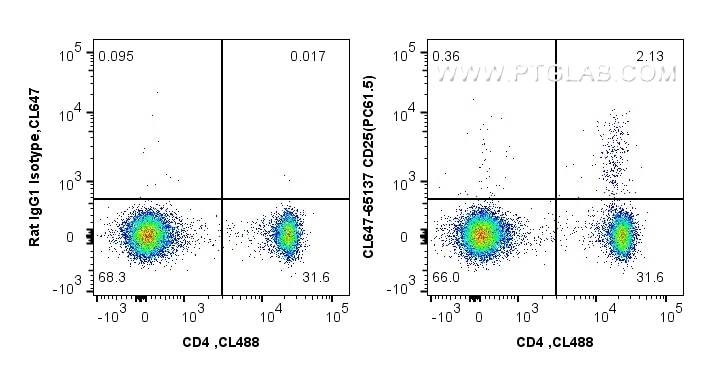CD25/IL-2RA Monoklonaler Antikörper
CD25/IL-2RA Monoklonal Antikörper für FC
Wirt / Isotyp
Ratte / IgG1, lambda
Getestete Reaktivität
Maus
Anwendung
FC
Konjugation
CoraLite® Plus 647 Fluorescent Dye
CloneNo.
PC61.5
Kat-Nr. : CL647-65137
Synonyme
Geprüfte Anwendungen
| Erfolgreiche Detektion in FC | Maus-Splenozyten |
Empfohlene Verdünnung
| Anwendung | Verdünnung |
|---|---|
| This reagent has been tested for flow cytometric analysis. It is recommended that this reagent should be titrated in each testing system to obtain optimal results. | |
| Sample-dependent, check data in validation data gallery | |
Produktinformation
CL647-65137 bindet in FC CD25/IL-2RA und zeigt Reaktivität mit Maus
| Getestete Reaktivität | Maus |
| Wirt / Isotyp | Ratte / IgG1, lambda |
| Klonalität | Monoklonal |
| Typ | Antikörper |
| Immunogen | k.A. |
| Vollständiger Name | interleukin 2 receptor, alpha chain |
| GenBank-Zugangsnummer | BC114437 |
| Gene symbol | CD25 |
| Gene ID (NCBI) | 16184 |
| Konjugation | CoraLite® Plus 647 Fluorescent Dye |
| Excitation/Emission maxima wavelengths | 654 nm / 674 nm |
| Form | Liquid |
| Reinigungsmethode | Affinitätsreinigung |
| Lagerungspuffer | PBS with 0.09% sodium azide and 0.5% BSA |
| Lagerungsbedingungen | Store at 2-8°C. Avoid exposure to light. Stable for one year after shipment. |
Hintergrundinformationen
Proliferation of T lymphocytes is triggered by the interaction of IL-2 with its specific receptor following T lymphocyte activation. The receptor for IL-2 has three forms, generated by different combinations of three different proteins, the alpha chain (IL-2R alpha), the beta chain (IL-2R beta), and the gamma chain (IL-2R gamma) (PMID: 8476561). IL-2R alpha (also known as CD25) is a type I transmembrane protein present on activated T cells, activated B cells, some thymocytes, myeloid precursors, and oligodendrocytes. CD25 is also found on natural CD4+Foxp3+ Treg cells (PMID: 22585674).
Protokolle
| PRODUKTSPEZIFISCHE PROTOKOLLE | |
|---|---|
| FC protocol for CL Plus 647 CD25/IL-2RA antibody CL647-65137 | Download protocol |
| STANDARD-PROTOKOLLE | |
|---|---|
| Klicken Sie hier, um unsere Standardprotokolle anzuzeigen |


